New Mexico’s dramatic landscapes—from forested mountains to sunbaked deserts—are home to an incredible diversity of hummingbirds. With vibrant colors, rapid wingbeats, and dazzling aerial displays, these tiny birds captivate birdwatchers across the state. From the fiery Rufous Hummingbird to the rare and exotic Lucifer and White-eared species, New Mexico offers one of the richest hummingbird experiences in the Southwest.
Throughout the year, especially during spring and late summer migration, hummingbirds flock to wildflower meadows, canyon edges, and backyard feeders. Their presence not only adds brilliance to the natural scenery but also plays an essential role in pollination and the health of native plant ecosystems. Whether you’re exploring the Gila Wilderness or watching from your porch in Santa Fe, you’re bound to encounter these winged jewels.
In this detailed guide, you’ll discover 20 hummingbird species found in New Mexico—with identification tips, behavior insights, and the best places to see them. Let’s explore what makes each one unique, and how you can welcome them into your own backyard habitat.
Common Hummingbirds Found in New Mexico
Broad-tailed Hummingbird (Selasphorus platycercus)
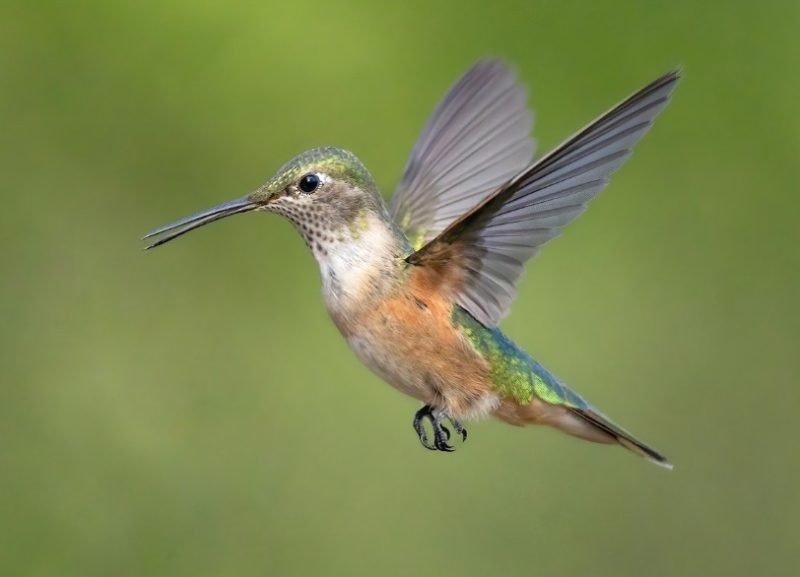
The Broad-tailed Hummingbird is one of the most commonly seen hummingbirds in the mountainous regions of New Mexico, especially during summer. Males are easily recognized by their iridescent rosy-pink throat, called a gorget, which contrasts with their green back and white underparts. Females and juveniles lack the bright gorget and have a more speckled throat. These birds measure about 3.5 to 4 inches in length with a wingspan of approximately 5.25 inches.
Broad-tailed Hummingbirds are known for their unique high-pitched wing trills, created by their rapid wingbeats during flight—especially by males during courtship displays. They are active, fast-flying birds that frequently visit flowers and feeders for nectar, but also feed on insects for protein. Their behavior includes hovering while feeding and fierce territorial defense around preferred nectar sources.
These hummingbirds breed in the high-elevation meadows and aspen forests of northern and central New Mexico, including areas like the Sangre de Cristo and Jemez Mountains. They migrate south to Mexico and Central America during winter. A fun fact: their hearts can beat over 1,200 times per minute during flight but slow dramatically during torpor, a hibernation-like state used to conserve energy on cold nights.
Black-chinned Hummingbird (Archilochus alexandri)
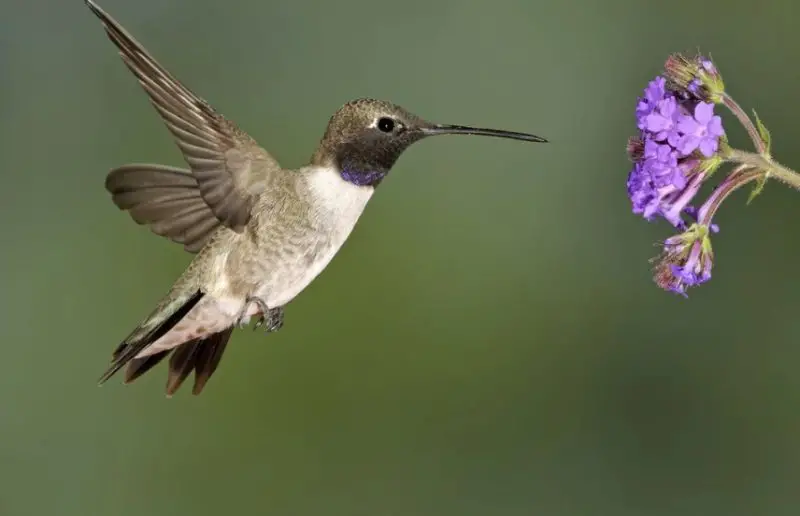
Black-chinned Hummingbirds are widespread throughout New Mexico and are particularly common in lower elevations, urban gardens, and along river corridors. Males have a distinctive black throat with a narrow iridescent purple band at the base, which may appear fully black unless caught in the right light. Females are duller, with a pale throat and greenish back. They are medium-sized for hummingbirds, measuring about 3.25 inches in length.
These hummingbirds are known for their subtle beauty and incredible adaptability. Their nesting behavior includes building tiny, well-camouflaged cup nests on branches, often near water. Males perform U-shaped aerial dives to impress females during the breeding season. Like other hummingbirds, they consume both nectar and small arthropods for sustenance.
In New Mexico, they are most often observed from spring through early fall across a wide range of habitats, including Albuquerque’s Bosque and the Rio Grande Valley. They migrate to western Mexico for the winter. An interesting fact: despite their small size, Black-chinned Hummingbirds have been recorded flying over 2,000 miles during migration.
Rufous Hummingbird (Selasphorus rufus)
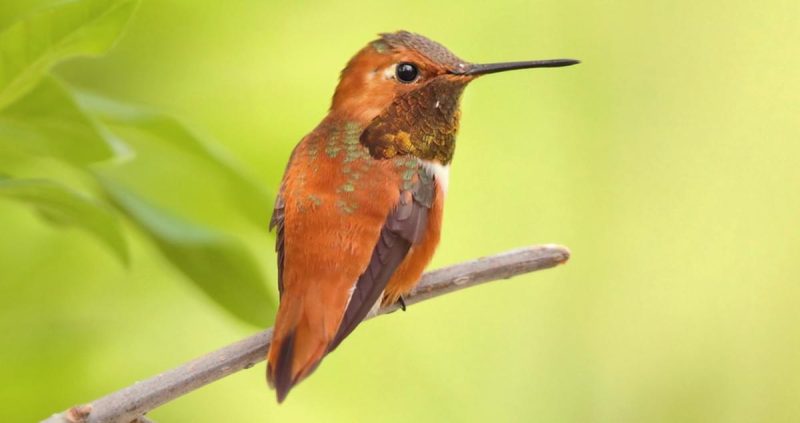
The Rufous Hummingbird is a fiery and aggressive little bird with remarkable stamina. Males are easy to identify thanks to their stunning reddish-orange throat and back, while females are greenish with rufous flanks and a spotted throat. These hummingbirds are among the smallest, measuring only about 3 inches long, but are famously territorial and pugnacious, even chasing away much larger birds from feeders.
These birds are energetic migrants and are known for having one of the longest migrations relative to body size of any bird species. They travel from breeding grounds in the Pacific Northwest and Canada all the way to Mexico for the winter. They are often seen in New Mexico during migration, especially in late summer as they move southward.
Rufous Hummingbirds can be spotted at high-elevation wildflower meadows, forest edges, and backyards with native flowering plants or hummingbird feeders. Places like the Gila Wilderness and Sandia Mountains are common stopovers. A fun fact: their memory is so precise that they can remember individual flowers and feeders from the previous year’s migration route.
Calliope Hummingbird (Selasphorus calliope)
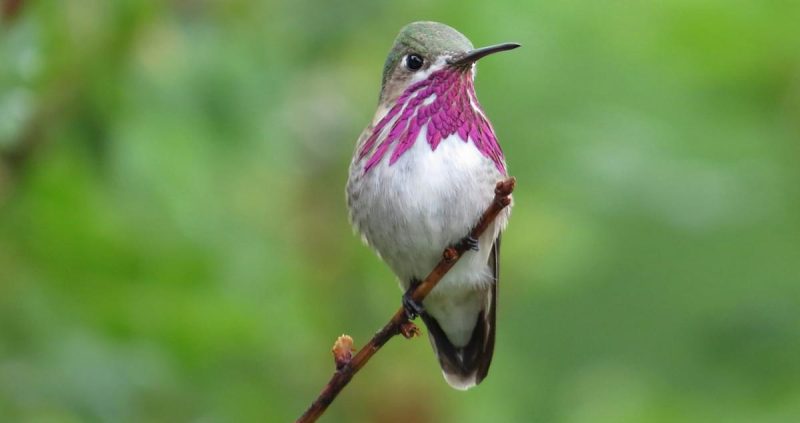
The Calliope Hummingbird holds the title of the smallest breeding bird in North America, measuring only about 3 inches long and weighing less than a penny. Males are easily recognized by their streaked magenta throat feathers, which they can flare out like a fan during courtship. Females lack the throat coloration and have a peachy wash on their flanks with greenish backs.
Despite their tiny size, Calliope Hummingbirds are tough, long-distance migrants. They breed in high-altitude meadows and forest openings and undertake a round-trip migration of more than 5,000 miles between the Pacific Northwest and Central America. During migration, they rely on mountain habitats, especially those rich in wildflowers and insects.
In New Mexico, Calliope Hummingbirds are most commonly seen during their migration in spring and late summer, particularly in the northern and central mountainous areas. Locations such as the Santa Fe National Forest or the Sangre de Cristo Mountains provide prime habitat. A fun fact: Calliopes are the only hummingbirds known to perform a shuttle display with aerial loops, all while making a zipping sound with their wings.
Anna’s Hummingbird (Calypte anna)
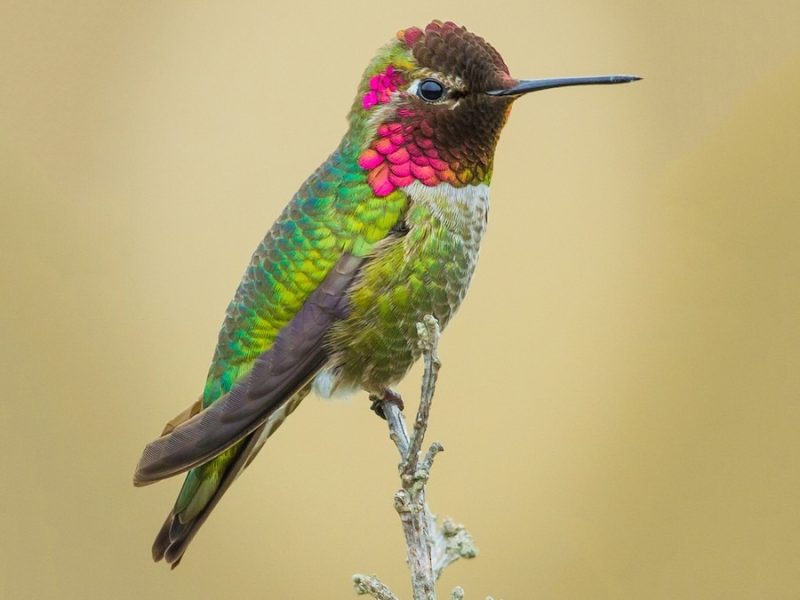
Anna’s Hummingbird is a striking species that has expanded its range eastward and can occasionally be found in New Mexico, particularly in the southwestern parts during migration or winter. Males are unmistakable with a vibrant, iridescent rose-pink crown and throat, which glisten brightly in sunlight. Females are duller with a pale throat that may show some pink speckles.
Unlike most hummingbirds, Anna’s Hummingbird is known to remain year-round in some areas rather than migrating. They are highly vocal and often produce a sharp, metallic chip as well as a buzzing song, which is unusual among hummingbirds. Their courtship display includes a dramatic dive from up to 100 feet, producing a loud tail-generated noise as they swoop past females.
In New Mexico, sightings of Anna’s Hummingbirds are more sporadic, but they have been documented in areas like Las Cruces, Silver City, and along the Rio Grande corridor. A fun fact: Anna’s Hummingbirds were named after Anna Masséna, a 19th-century French duchess, making them one of the few hummingbirds named after nobility.
Lucifer Hummingbird (Calothorax lucifer)
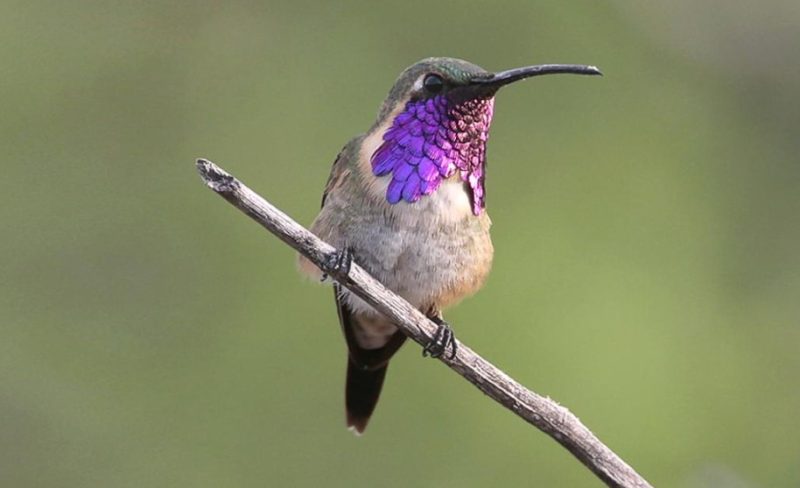
The Lucifer Hummingbird is one of the more exotic and rare species found in New Mexico, known for its striking appearance and preference for desert habitats. Males are particularly eye-catching, with a long curved bill and a brilliant purple, forked gorget that shimmers in the light. Their body is mostly green above and pale below. Females are duller and lack the vivid throat coloring, but also feature the curved bill which is unique among hummingbirds in the region.
This hummingbird is well-adapted to arid environments and is primarily found in desert canyons and dry scrublands, particularly in the southwestern part of the state. They are known for feeding on nectar from desert-adapted plants like agave and ocotillo, often hovering low near blooms. Their movement tends to be quick and deliberate, and they are less aggressive than their rufous cousins, preferring to forage quietly.
In New Mexico, Lucifer Hummingbirds are most often seen in places like the Peloncillo Mountains and Guadalupe Canyon, near the border with Arizona and Mexico. A fascinating fact: this species has one of the most specialized bills among North American hummingbirds, allowing it to feed efficiently on long, tubular desert flowers.
Costa’s Hummingbird (Calypte costae)
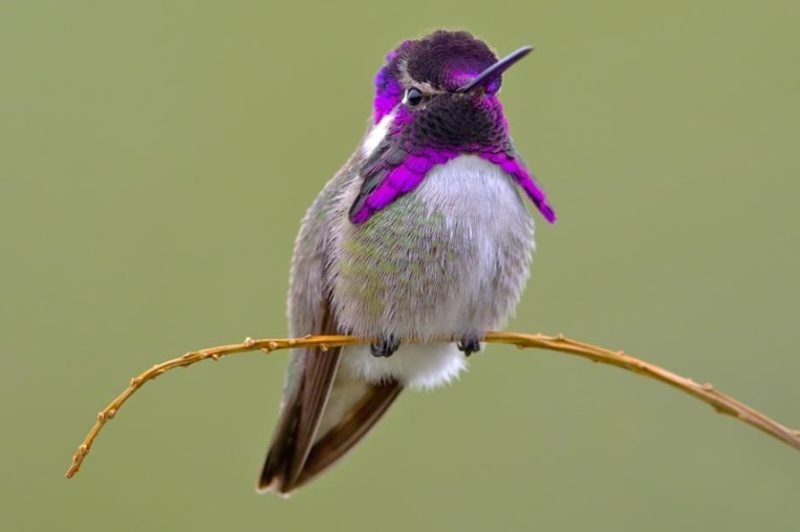
Costa’s Hummingbird is a desert-dwelling species occasionally found in New Mexico, mostly in the southwestern parts during migration. The male is unmistakable, with a vivid violet-purple crown and throat that flare out into long, pointed feathers resembling a mustache. Females are much more subdued in appearance, with pale grayish underparts and greenish backs.
This small hummingbird is typically associated with hot, dry habitats, especially deserts, rocky canyons, and scrubland. It feeds primarily on nectar from desert wildflowers and also supplements its diet with small insects. Males are known for their high-pitched, whistling courtship display dives, which they often perform from a prominent perch.
Although Costa’s Hummingbird is more common in the Sonoran and Mojave deserts, it is occasionally observed in New Mexico near Las Cruces, Silver City, and other arid southern regions. A fun fact: during courtship, males can control the angle of sunlight hitting their throat feathers, making their purple gorget flash dramatically to attract females.
Broad-billed Hummingbird (Cynanthus latirostris)
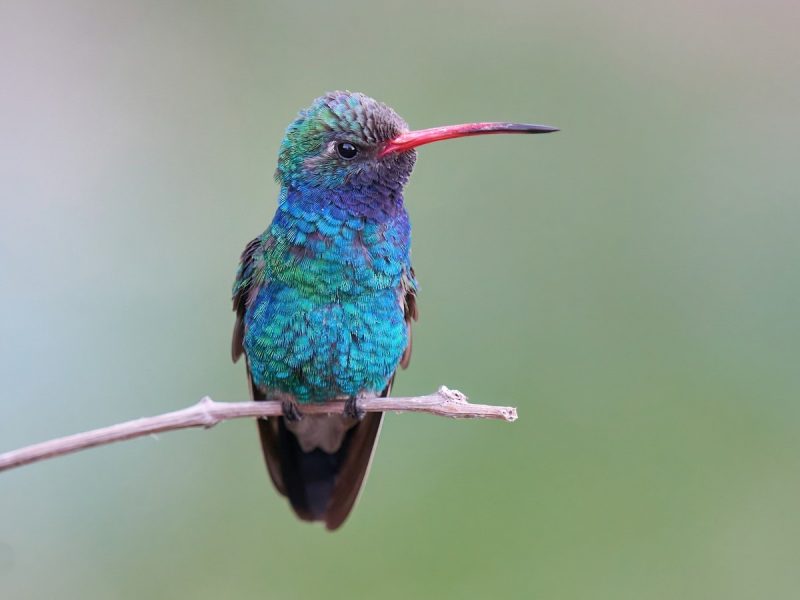
The Broad-billed Hummingbird is a dazzling species with tropical flair, more common in Mexico but sometimes observed in New Mexico’s southern canyons. Males have a striking metallic green body, a vivid blue throat, and a bright red bill with a black tip. Females are more muted but still attractive, with green upperparts and pale underparts.
This hummingbird is most often associated with riparian corridors and desert scrub near water sources, where it visits tubular flowers and feeders. Its broad, vivid bill and energetic behavior make it a standout among southwestern species. The Broad-billed Hummingbird is also one of the few North American hummingbirds that can breed in two countries: the U.S. and Mexico.
In New Mexico, they are seen primarily in the far southwestern areas like the Gila River Valley and Guadalupe Canyon, especially during summer. A fascinating note: the Broad-billed Hummingbird often flares its tail while hovering, flashing white tail tips as part of territorial or courtship behavior.
Allen’s Hummingbird (Selasphorus sasin)
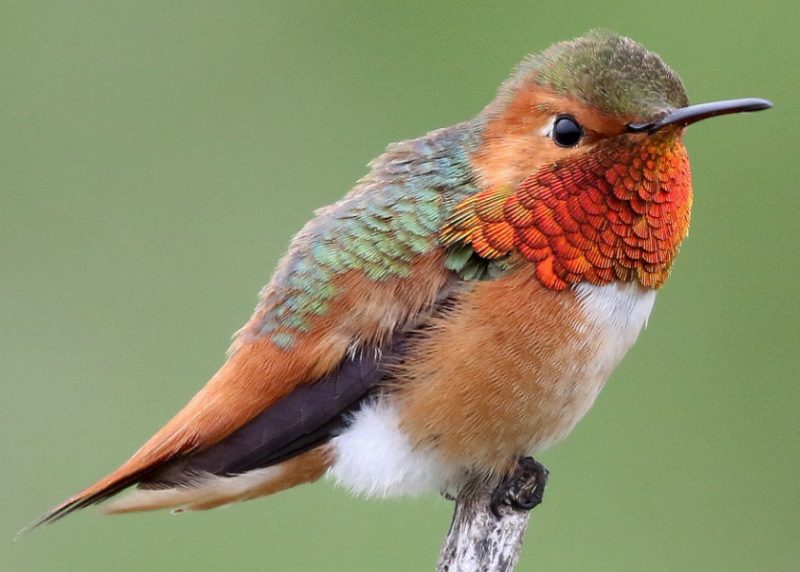
Allen’s Hummingbird is a close relative of the Rufous Hummingbird and is notoriously difficult to distinguish in the field due to similar coloring. Males sport a vibrant orange-red throat and rusty body with a green back, while females are green above with pale underparts and a spotted throat. They are small, only about 3 inches in length, but very bold and active.
These hummingbirds are known for their rapid, darting flight and intense territorial behavior. They perform a distinctive courtship dive that ends in a sharp buzzing sound generated by their tail feathers. Allen’s Hummingbirds feed primarily on nectar and small insects, often visiting native plants like fuchsia, columbine, and penstemon.
While they are primarily found along the California coast, vagrant individuals are occasionally spotted in New Mexico, particularly during migration. Most sightings occur in southern regions or in gardens with abundant nectar sources. A fun fact: Allen’s Hummingbird is named after Charles A. Allen, the first person to describe the species in the late 19th century.
Violet-crowned Hummingbird (Leucolia violiceps)

The Violet-crowned Hummingbird is a unique and elegant species with a clean, crisp appearance. Adults have a brilliant violet-blue crown, white underparts, green back, and a straight red bill with a black tip. Unlike many hummingbirds that display iridescent throats, this species is recognized by its bold coloration and graceful posture.
These hummingbirds prefer oak woodlands, canyons, and riparian habitats, particularly in the borderlands of southern New Mexico. They feed on nectar from native flowers and are also frequent visitors to backyard feeders. Their flight is swift but smooth, and they are known to be less aggressive than some other hummingbird species.
In New Mexico, the Violet-crowned Hummingbird is most reliably seen in the far southwest corner, particularly around the town of Portal and the surrounding canyons. A fun fact: despite being relatively rare in the U.S., this species is quite common in western Mexico, making New Mexico one of the best states to see it within the country.
White-eared Hummingbird (Hylocharis leucotis)

The White-eared Hummingbird is a striking species with bold facial markings and a preference for mountainous forested habitats. Adults feature a green body, white underparts, and a distinctive white stripe behind the eye that gives the species its name. Males have a bright red bill with a black tip and sometimes show a bit of iridescent violet on the throat. Females are similar but slightly duller and less vibrant overall.
This hummingbird tends to favor pine-oak woodlands and forest edges at higher elevations, often near flowing water and flowering plants. It feeds on nectar and small insects and is more frequently seen at natural flower sources than feeders. Though shy and less aggressive than other hummingbirds, it defends feeding areas when needed.
In New Mexico, the White-eared Hummingbird is considered rare and local, usually found in the extreme southwestern canyons such as those near the Peloncillo Mountains. A fun fact: this species is more common in Mexico and Central America, but New Mexico is one of the few U.S. states where birders have the chance to spot it in the wild.
Magnificent Hummingbird / Rivoli’s Hummingbird (Eugenes fulgens)
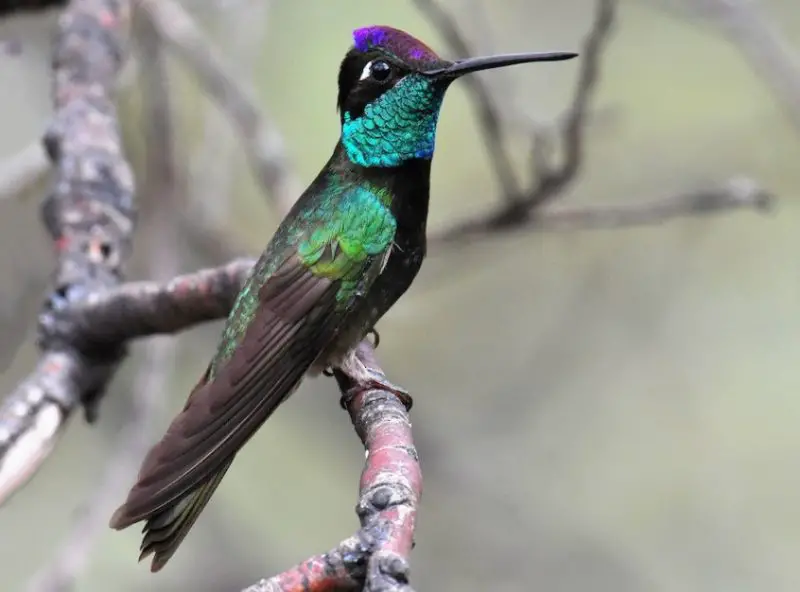
Among the largest hummingbirds found in the United States, the Magnificent Hummingbird—now often referred to as Rivoli’s Hummingbird—is a showstopper. Males are particularly eye-catching with a metallic green body, iridescent violet crown, and bluish-green throat. Females are duller with green upperparts and grayish underparts, but still larger than most hummingbird species.
This species prefers shady, high-elevation coniferous or mixed woodlands and is often seen near mountain streams and canyon thickets. It is known for its deep, thrumming wingbeat and ability to hover for extended periods while feeding. Magnificent Hummingbirds are more solitary than other hummingbirds and less prone to squabbling over feeders.
In New Mexico, Rivoli’s Hummingbirds are typically found in the southwestern mountains, such as the Gila Wilderness and adjacent areas. A fun fact: the species was originally named in honor of the Duke of Rivoli, a 19th-century Italian nobleman and bird enthusiast.
Blue-throated Mountain-gem (Lampornis clemenciae)

The Blue-throated Mountain-gem is the largest hummingbird species native to the U.S., and it lives up to its name with a vibrant blue throat that shimmers in males when seen in good light. Both sexes have grayish underparts, a green back, and a distinct white stripe behind the eye. Its large size and strong, direct flight make it stand out even among other hummingbirds.
This species is typically found in shaded mountain canyons and along streams at elevations between 5,000 and 9,000 feet. Unlike smaller hummingbirds, it is less flitty and can perch more calmly for long periods. It is vocal and produces a loud, chipping call that can be heard from a distance.
In New Mexico, the Blue-throated Mountain-gem is found in the southwestern mountains and canyons, especially in the Chiricahua and Peloncillo ranges. A fun fact: their nests are sometimes reused in multiple seasons, often being reinforced and rebuilt rather than entirely discarded.
Berylline Hummingbird (Saucerottia beryllina)
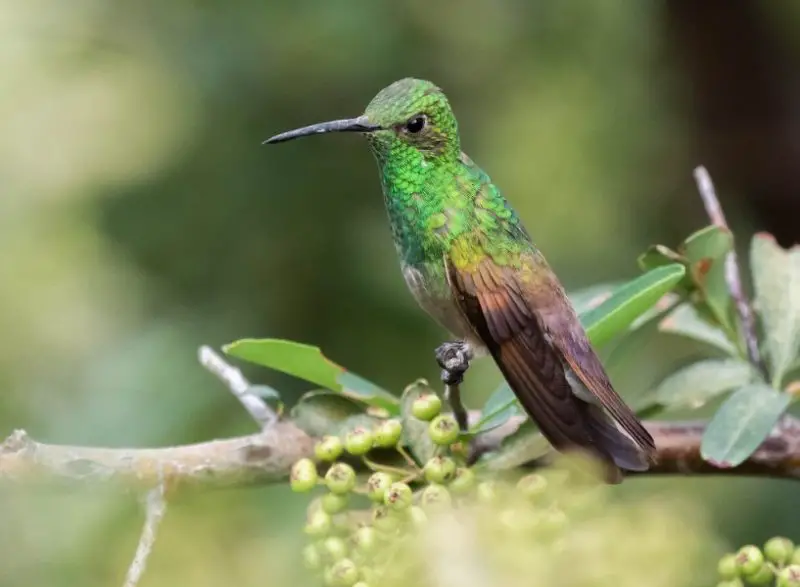
The Berylline Hummingbird is a rare but radiant visitor to New Mexico, characterized by its glossy green body and rusty-colored wings. Males and females look quite similar, with a shimmering emerald plumage that sparkles in sunlight and a somewhat straight dark bill. The wings appear chestnut or cinnamon-brown in flight, giving the bird a unique appearance compared to other hummingbirds.
Berylline Hummingbirds inhabit oak and pine-oak woodlands, often along streams and mountain slopes. They feed on nectar from native flowers and will also catch small insects mid-air. While typically solitary, they can be aggressive at feeding stations when challenged.
In New Mexico, sightings are most frequent in the summer within the extreme southwestern canyons near the Arizona border. A fun fact: though rarely seen in the U.S., this species is common in the highlands of western Mexico, making New Mexico one of the few U.S. states where it occasionally appears.
Green Violet-ear / Mexican Violetear (Colibri thalassinus)

The Green Violet-ear, often called the Mexican Violetear, is a medium-sized hummingbird with brilliant emerald green plumage and violet patches on the sides of its neck. Males and females look similar, both shimmering in various shades of green with flashes of blue-violet when they catch the light. They also have a slightly notched tail edged with black and violet.
This species is typically found in humid forests and montane woodlands in Mexico and Central America, but individuals occasionally wander far north into the southwestern United States. They are strong, fast fliers and often vocal, producing a rapid and repeated metallic “tzilick” call. They feed on both nectar and small insects, and will readily visit feeders.
In New Mexico, the Green Violet-ear is considered a rare vagrant but has been recorded multiple times, particularly in late summer. A fun fact: this species is known for its unpredictable migratory behavior, sometimes showing up hundreds of miles outside its typical range, making each sighting in New Mexico a special event for birders.
Cinnamon Hummingbird (Amazilia rutila)

The Cinnamon Hummingbird is a warm-colored, tropical species that is only rarely seen in New Mexico. It features a bronze-green back, cinnamon-colored underparts, and a slightly decurved red bill with a black tip. Both males and females share this color pattern, which makes the species easy to recognize if encountered.
This hummingbird is primarily a resident of coastal and inland tropical regions in Mexico and Central America. It prefers dry forests, woodland edges, and gardens with plenty of flowering shrubs. Though it rarely migrates long distances, individuals have occasionally wandered into the southwestern United States, including New Mexico, likely following monsoonal flower blooms.
Sightings in New Mexico are exceptionally rare but have been documented in the southwestern desert canyons. A fun fact: unlike most hummingbirds, the Cinnamon Hummingbird may be more tolerant of open, drier environments and can sometimes be seen perched for long periods, showing off its cinnamon-colored chest.
Ruby-throated Hummingbird (Archilochus colubris)
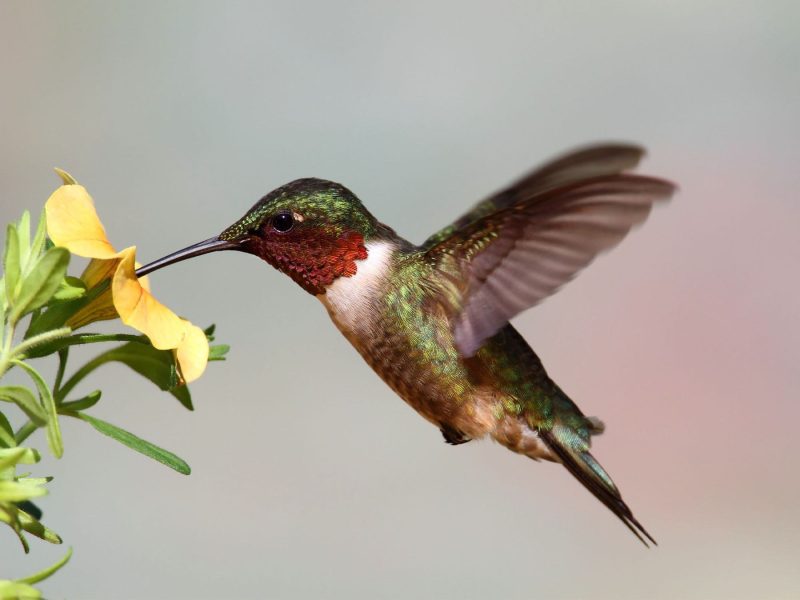
The Ruby-throated Hummingbird is the iconic hummingbird of the eastern United States but is only an occasional visitor to New Mexico. Males are easily identified by their iridescent ruby-red throat, emerald green back, and white underparts. Females are less colorful, with a pale throat and green upperparts.
This species is a long-distance migrant, flying nonstop across the Gulf of Mexico to wintering grounds in Central America. Ruby-throated Hummingbirds feed heavily on nectar and insects, visiting gardens and wildflowers along their route. Though they are very territorial on the breeding grounds, their presence in New Mexico is more fleeting and typically solitary.
Ruby-throated Hummingbirds are sometimes spotted in eastern or central New Mexico during migration, especially in areas with reliable nectar sources or feeders. A fun fact: this species can beat its wings over 50 times per second and can remember the location of flowers on its previous migration route.
Buff-bellied Hummingbird (Amazilia yucatanensis)

The Buff-bellied Hummingbird is a rare vagrant in New Mexico, more commonly found in the Gulf Coast of Texas and northeastern Mexico. It has a striking appearance with metallic green upperparts, a buffy-colored belly, and a long red bill with a dark tip. Both sexes look similar, and their size is slightly larger than many common U.S. hummingbirds.
This hummingbird prefers subtropical scrub, woodland edges, and gardens with flowering plants. It is known for being more adaptable than some species, and is often found near human habitation. Buff-bellied Hummingbirds are also known for their loud, sharp vocalizations, which help them defend feeding territories.
In New Mexico, sightings are extremely rare but have occurred, particularly in the southeastern part of the state. A fun fact: the Buff-bellied Hummingbird is known to overwinter farther north than most hummingbirds, sometimes staying year-round in parts of southern Texas.
Green-fronted Hummingbird (Ramosomyia viridifrons)

The Green-fronted Hummingbird is a tropical species usually found in the woodlands of Mexico and Central America, but rare individuals have occasionally been reported in the southwestern U.S., including New Mexico. Males show bright green plumage with a shimmering front and pale underparts, along with a straight red bill tipped in black.
This bird typically inhabits oak and pine-oak forests, feeding on nectar from native flowers as well as catching insects in flight. It is not often seen at feeders but may occasionally visit them when flowering sources are limited. Its behavior is less aggressive than species like Rufous or Allen’s Hummingbird, and it is often quiet and deliberate in movement.
In New Mexico, it is considered a very rare vagrant, with just a handful of records in the far south of the state. A fun fact: the Green-fronted Hummingbird was previously considered a subspecies of the Violet-crowned Hummingbird, but has since been recognized as a distinct species due to differences in range and coloration.
Mexican Violetear (Colibri thalassinus)
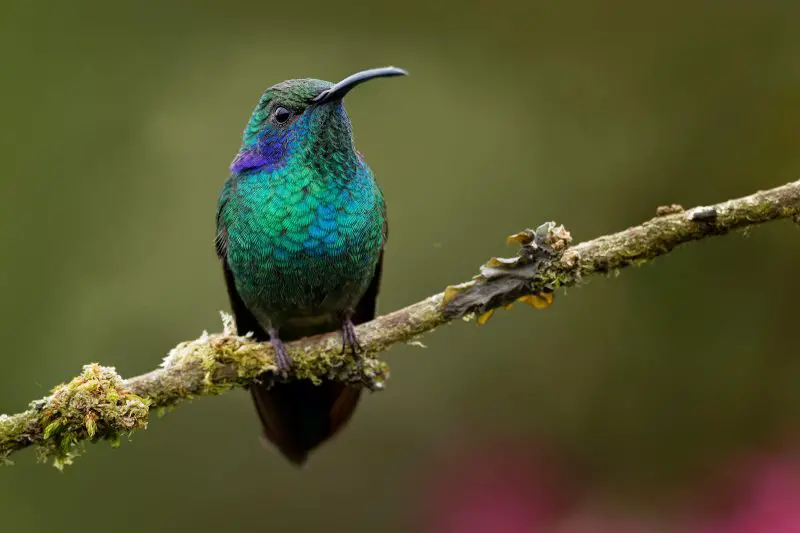
The Mexican Violetear, also known simply as the Green Violetear, is a medium-sized hummingbird with shimmering green feathers and a violet patch on both the cheek and chest. Males and females look alike, making it one of the few hummingbird species without strong sexual dimorphism. Its call is a series of rapid “tzilick” notes, often given while flying or perched.
This species is native to the highlands of Mexico and Central America but is famous for wandering widely. While not a regular resident of the U.S., the Mexican Violetear occasionally travels far north, sometimes appearing in unexpected locations such as Texas, Colorado, and New Mexico.
In New Mexico, sightings occur sporadically, often during late summer in mountainous or forested areas. A fun fact: this species is one of the most unpredictable hummingbirds in terms of migration, with some individuals recorded thousands of miles outside their normal range, making any sighting in New Mexico a prized experience for birders.
FAQs about Hummingbirds in New Mexico
When is the best time to see hummingbirds in New Mexico?
The best time to observe hummingbirds in New Mexico is from late March through early October, with peak activity during late summer, especially August and early September. This period coincides with southbound migration and late blooming of native flowers. Some species, like the Broad-tailed and Black-chinned Hummingbirds, arrive in spring to breed, while rarer species are more likely spotted in late summer.
Where can I see hummingbirds in New Mexico?
Hummingbirds can be seen statewide, but the best viewing spots are usually in mountainous areas, riparian corridors, and southern desert canyons. Locations like the Gila Wilderness, Sandia Mountains, Bosque del Apache, and Guadalupe Canyon are renowned for hummingbird diversity, especially during migration. Backyard feeders in Albuquerque, Santa Fe, and Silver City also attract many species.
Do all hummingbirds in New Mexico migrate?
Most hummingbirds in New Mexico do migrate, heading south to Mexico or Central America for winter. Some, like the Anna’s Hummingbird, may overwinter occasionally in southern areas, though this is rare. Migration patterns vary by species—Rufous, Calliope, and Broad-tailed Hummingbirds are especially notable for long-distance travel.
How can I attract hummingbirds to my yard in New Mexico?
To attract hummingbirds, plant native nectar-rich flowers like penstemon, columbine, bee balm, and salvia. Use red hummingbird feeders filled with plain sugar water (1 part sugar to 4 parts water—no dye). Keep feeders clean, especially in hot weather, and provide shade, perching spots, and water features to make your yard more inviting.
Are there rare hummingbirds in New Mexico?
Yes, New Mexico is known for hosting rare and vagrant species, including Lucifer, White-eared, Berylline, Mexican Violetear, and Buff-bellied Hummingbirds. These species typically appear in southern canyons or mountains, often in late summer, and attract birdwatchers from across the country when spotted.
How many species of hummingbirds are found in New Mexico?
A total of 20 hummingbird species have been documented in New Mexico. While not all are regular visitors, several are breeding residents, others are migratory, and some are occasional or rare vagrants. New Mexico’s location at the edge of the desert Southwest and mountainous regions makes it a prime hotspot for hummingbird diversity.
Do hummingbirds fight over feeders?
Yes, hummingbirds can be extremely territorial, especially males. Species like the Rufous Hummingbird are particularly aggressive and often chase away others from feeders or flowers. Providing multiple feeders spaced apart can help reduce conflict and allow more individuals to feed peacefully.
Are hummingbirds active at night in New Mexico?
Hummingbirds are diurnal and do not feed at night. At sunset, they seek shelter in trees or shrubs and enter torpor, a sleep-like state that helps conserve energy. You may see them again early in the morning, often at the same flowers or feeders they visited the day before.
What should I avoid feeding or planting for hummingbirds?
Avoid using red dye in nectar, as it can be harmful. Also avoid non-native plants that produce little or no nectar, or those treated with pesticides. Some garden centers sell hummingbird food with additives, which should be avoided in favor of a homemade, natural sugar-water solution.
Are hummingbirds important to the ecosystem in New Mexico?
Absolutely. Hummingbirds are essential pollinators for many native plants in New Mexico’s forests, deserts, and meadows. Their interaction with flowers helps maintain biodiversity and supports other wildlife. Their presence also indicates healthy ecosystems and makes them key figures in local conservation efforts.







Need to have photos of both sexes since they vary in color.